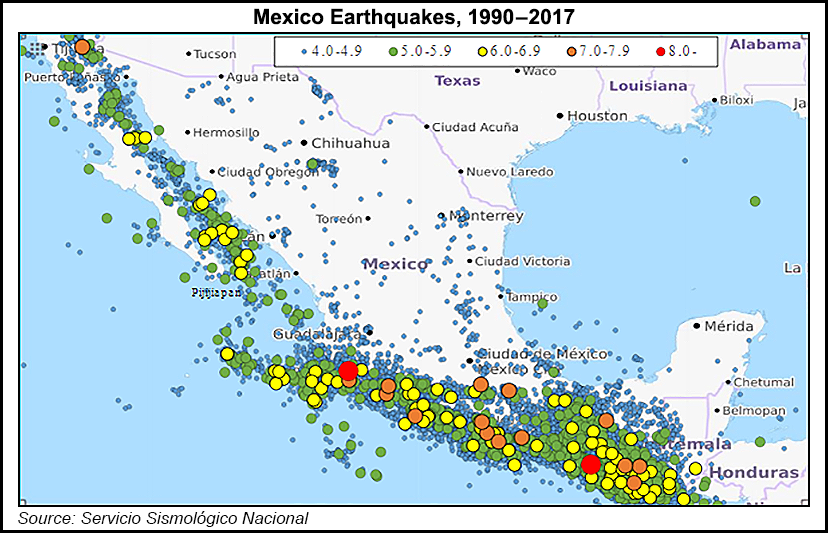Regulatory | Infrastructure | NGI All News Access
Lopez Obrador Expected to Decentralize Mexico City’s Pemex, Energy Offices
Mexico President-Elect Andres Manuel Lopez Obrador aims to decentralize the government in a sweeping plan to ease the congestion of population, buildings, vehicles and pollution in the “megalopolis” of Mexico City, a strategy likely to impact the country’s energy sector from top to bottom.

The government agencies set to be relocated to the provinces include state-owned Petroleos Mexicanos (Pemex); state power utility Comision Federal de Electricidad (CFE); energy ministry the SecretarÃa de EnergÃa (Sener), as well as the energy regulators, the Comision Nacional de Hidrocarburos (CNH) and the Comision Reguladora de Energia (CRE).
Under the plan, Pemex headquarters would be moved from its 51-story Mexico City tower to Ciudad del Carmen on the southeastern Gulf Coast, a base of support that supplies operations in the Sound of Campeche, where most oil and gas is produced.
Sener, CNH and CRE are slated to be moved to Villahermosa, capital of Tabasco, the state where Lopez Obrador was born.
The age of the internet should ease the transition. These days, almost all government business is conducted online.
Since the 2013-14 energy reform, sessions of the CNH and CRE have been broadcast live by Internet, and the rules of both regulators insist in keeping a distance from representatives of the companies involved in auctions.
In order to ensure transparency and avoid any hint of corruption, CNH and CRE commissioners have to provide reports to their superiors of meetings with representatives of companies, rather as diplomats of the Western and Soviet blocks did whenever they met each other at cocktail parties during the Cold War.
The Federal District of Mexico City and its surrounding conurbation currently houses a population of close to 20 million.
Public transportation is far from adequate and roads are often gridlocked. Working hours in Mexico are the longest in the Organization for Economic Co-operation and Development, aka OECD. Many people spend four hours a day — two each way — between their homes and their workplaces.
Speaking in a video produced by his Morena party, Lopez Obrador said that the decentralization plan should help improve the quality of life in the capital as well as providing more equal opportunities for the nation’s regions.
“There are islands of rapid growth in the country, but they are surrounded by areas that have been abandoned,” he said.
Yet another reason, he added, was the susceptibility of the capital to earthquakes. About 10,000 people died in the 1985 earthquake. Since then, stricter building regulations and the use of more sophisticated technology have improved safety standards. Even so, two severe tremors last September caused at least 465 deaths, and 180,000 homes were destroyed in the capital and in southern Mexico.
The plan to decentralize is to be executed steadily, in a process that is likely to take almost all of the six years of the upcoming administration and with a minimum of disruption, according to Monterrey-based businessman Alfonso Romo, who Lopez Obrador has named to be his chief of staff.
Under the plan, five key ministries would remain in Mexico City: Gobernacion, the Interior ministry; the Finance and Foreign ministries; the ministries of Defense (Army and Air Force), and the Navy.
López Obrador has said on several occasions that, as president, he will live and work in the National Palace in the historic center of Mexico City, where critics claim his presence will make even worse the gridlock that often besets the area.
For decades, Mexican presidents have worked and lived in the relatively leafy surroundings of Los Pinos, the Mexican equivalent of the White House.
The Pemex tower, in a nondescript but central barrio of Mexico City, is now one of several tall buildings that dot the Mexico City skyline. But when it was built in the early 1980s it was by far the nation’s largest building and a symbol of Mexico’s huge oil boom that ended in an equally spectacular financial crash and the nationalization of the Mexican banks.
The corporate offices of the CFE are in a much more elegant part of central Mexico City than where the Pemex tower is located. The Energy Ministry is currently housed in the south of the capital, near the Plaza de Toros, the largest bullring in the world.
© 2024 Natural Gas Intelligence. All rights reserved.
ISSN © 1532-1231 | ISSN © 2577-9877 |
